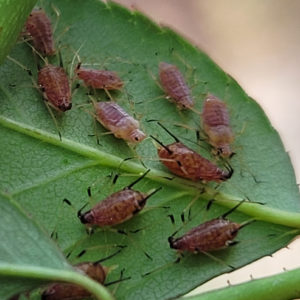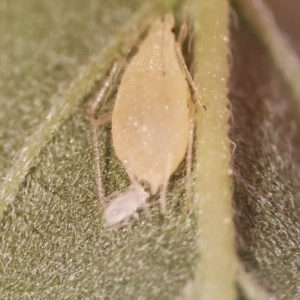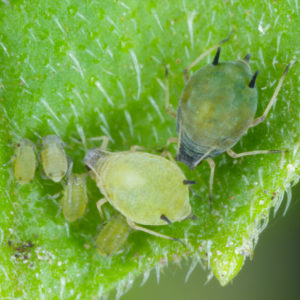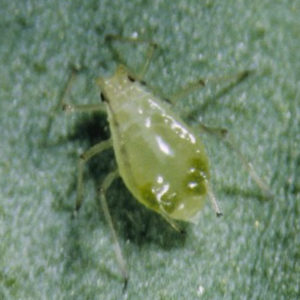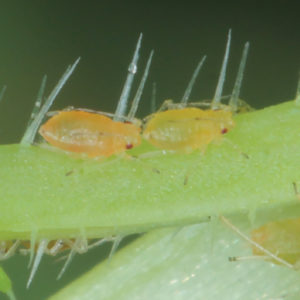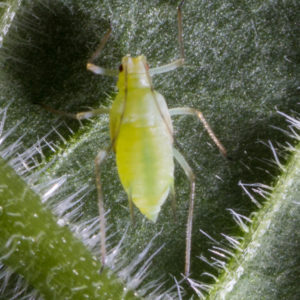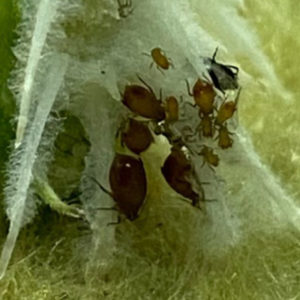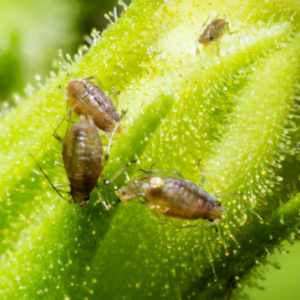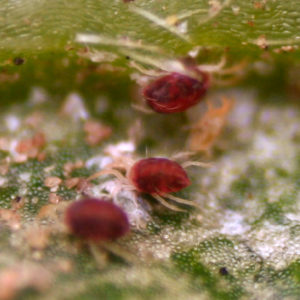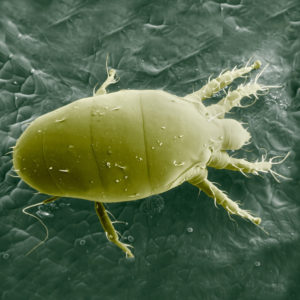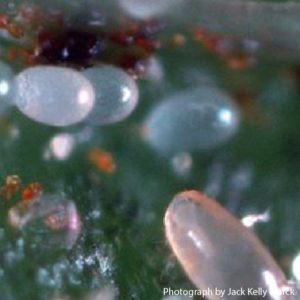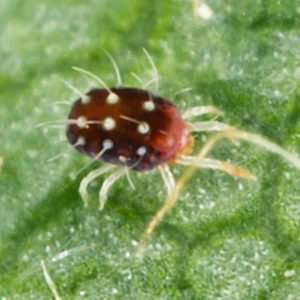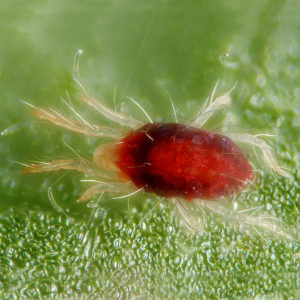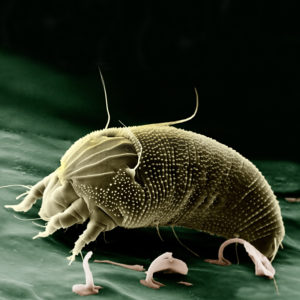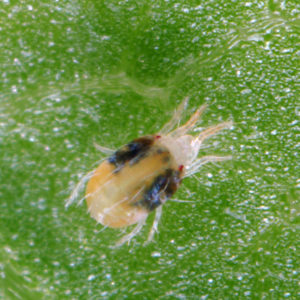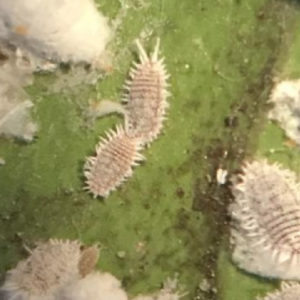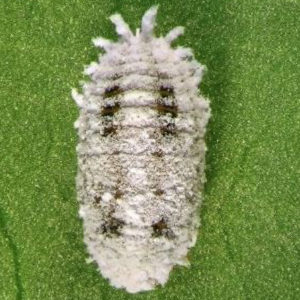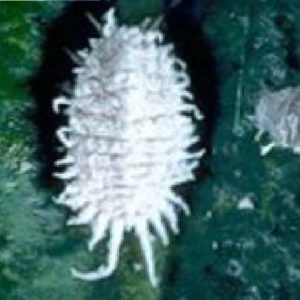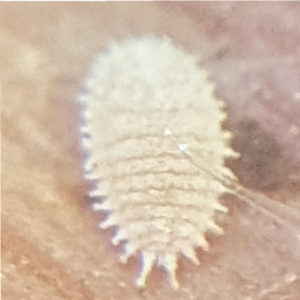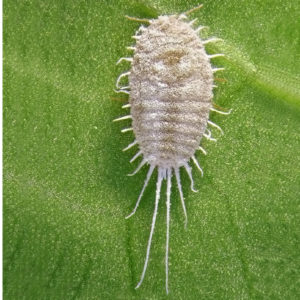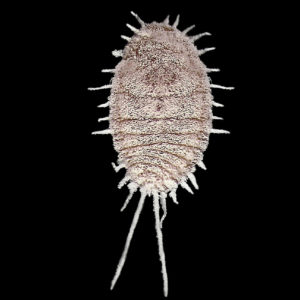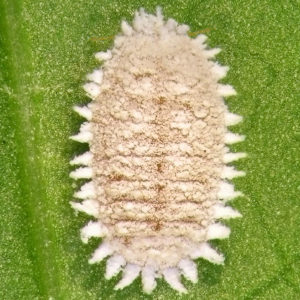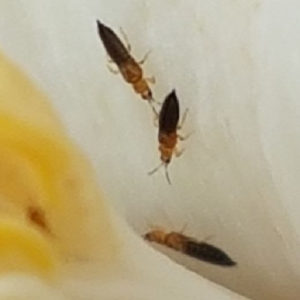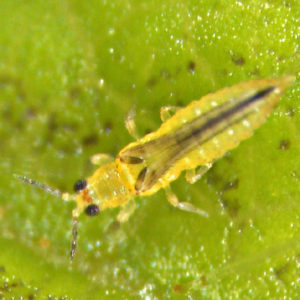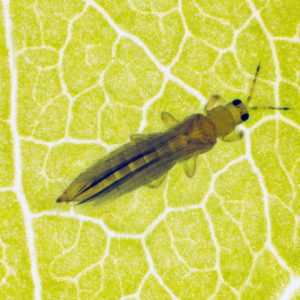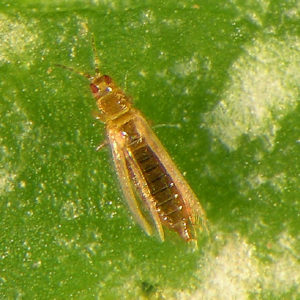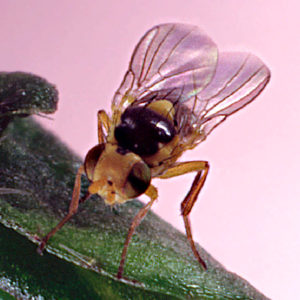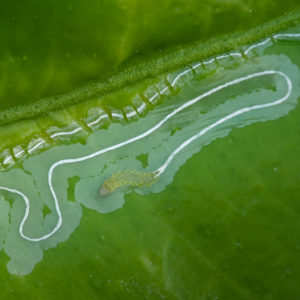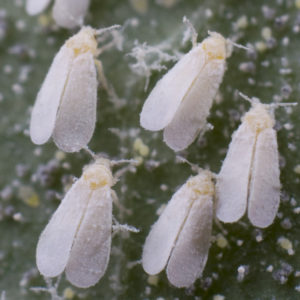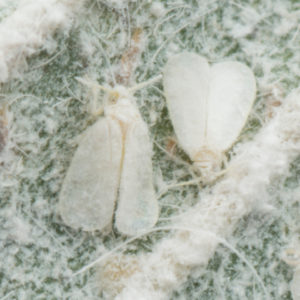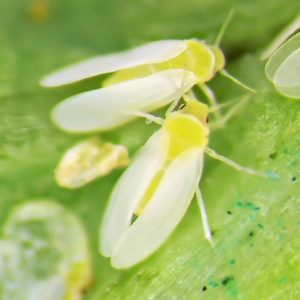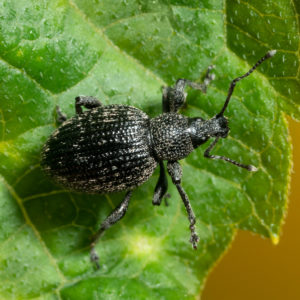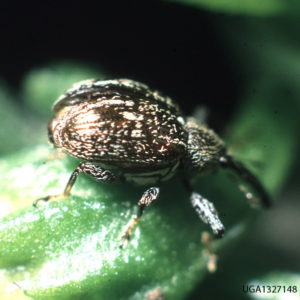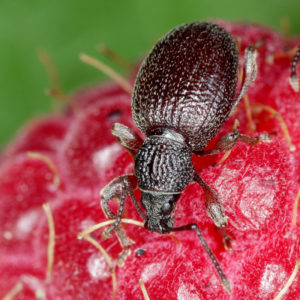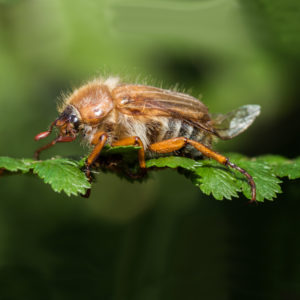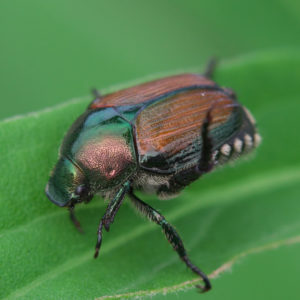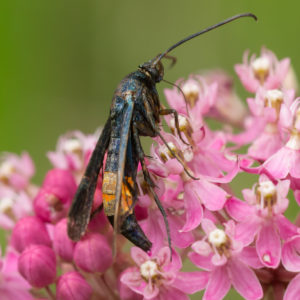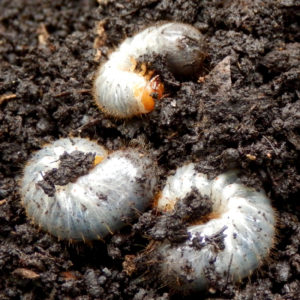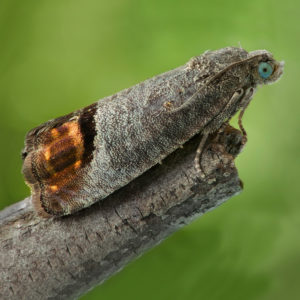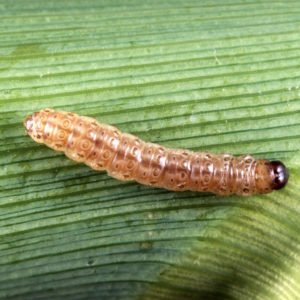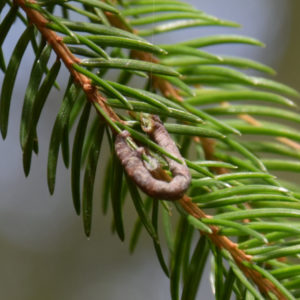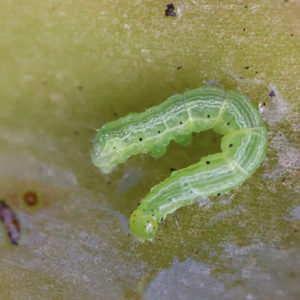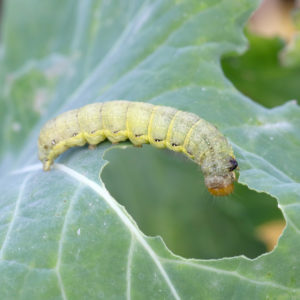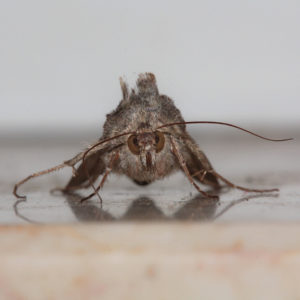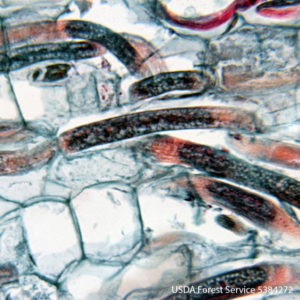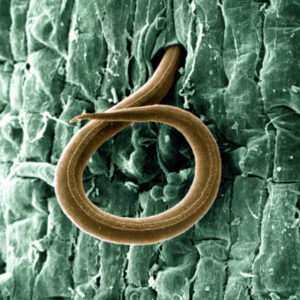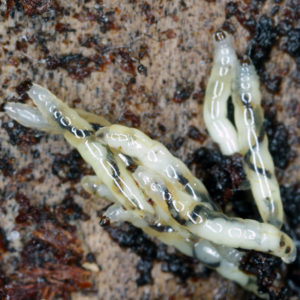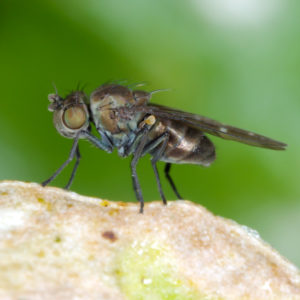There are many species of Aphids (peach potato aphid, cotton aphid, potato aphid, cannabis aphid, rice root aphid, foxglove aphid), while some are host specific (monophagous), others feed on many plant species (polyphagus). Aphids come in many colors (white, black, brown, gray, yellow, light green, or even pink) and can also vary considerably within the species. Some may have a waxy or woolly coating. Scouting and identification are key to using appropriate control strategies.
Cannabis aphid
The cannabis aphid (Phorodon cannabis) is pale yellow and later turn light green or pink with darker green stripes running the length of the body. The siphunculis are white and short, almost a third of the insect’s body length. Phorodon cannabis aphids reproduce asexually; females are essentially born pregnant and give birth to live, genetically identical offspring.
Cotton aphid
The cotton aphid (Aphis gossypii) is found on more than 700 plant species making it one of the most biologically diverse and widely distributed aphid species. A distinguishing mark is that the siphunculis are always black no matter the color of the aphid which can vary from light yellow to light green and even very dark green (almost black).
Foxglove aphid
The foxglove aphid (Aulacorthum solani) is also known as the glasshouse-potato aphid; pear shaped and shiny yellow to pale green, it is capable of infesting a wide variety of ornamental and vegetable plants. The antennae have darkened joints and are slightly longer than the body while their siphunculi are pale with dark tips and are characterized by a darker green or rust colored patch at their base.
Green peach aphid
The green peach aphid (Myzus persicae) can be yellowish-green, red, or brown in color because of morphological differences influenced primarily by the host plants, nutrition and temperature. In colder conditions they are often darker. Myzus persicae have long antennae and their siphunculi are slightly swollen towards the tips and have a rather pointed cauda.
Potato aphids
Potato aphids (Macrosiphum euphorbiae) prefer feeding on plants in the Chenopodiaceae family. They can appear green or reddish-pink; may be winged or wingless and have a preference for Solanaceae plants (potatoes in particular) yet have been identified in many vegetable and ornamental crops; therefore, scouting and identification are key.
Rice root aphid
Rice root aphids (Rhopalosiphum rufiabdominalis) also known as the red rice root aphid, prefer soil and media surroundings, making it difficult to detect. They can appear dark green to brown with yellow or red tinges and like most aphids, may be winged or wingless. The winged rice root aphid will emerge to colonize new plants. Female rice root aphids give live birth to genetically identical daughter offspring that mature quickly. Nymphs and adults feed on all plant development stages.
Tobacco aphid
The tobacco aphid (Myzus persicae subsp. nicotianae), a key pest in tobacco crops is also encountered in a wide range of greenhouse crops such as sweet pepper, eggplant, chrysanthemum and ornamental crops.
Spider mites
There are many species of spider mites (around 1,200 species) all belonging to the family Tetranychidae. They generally prefer living in the undersides of leaves, where they spin protective silk webs which are also used as a means to protect their colonies as well as to travel from plant to plant. Spider mites can be difficult to spot but if unchecked, later move to the upper leaves. Spider mites vary in color, thus scouting and identification are key.
Broad mites
The broad mite (Polyphagotarsonemus latus), is a small species of mite found on many species of plants, including important agricultural crops such as grapes, cannabis, sweet pepper, chili peppers, eggplant, cucumber, ornamentals and others. The mite’s oval-shaped eggs are laid on the underside of the leaf or on fruit surfaces. The mites prefer areas of high humidity and low temperature and are a major pest in greenhouses.
Cyclamen mite
Cyclamen mite (Phytonemus pallidus) are tiny mites (less than 0.5mm long) that feed on plant sap by penetrating the plant tissue with its piercing-sucking mouth parts. The mites are mostly found on the underside of leaves, within the flower buds, growing tips and young folded leaves, away from direct sunlight.
European red mite
The European red mite (Panonychus ulmi), also known as the fruit tree red mite attacks fruit trees but can also be a problem in grape vines, ornamentals and roses. The European red mite does not produce large amounts of webbing like the two-spotted spider mite (Tetranychus urticae). The female lays its eggs on the leaves and overwinters in the egg stage. In temperate climates, the “winter eggs” are laid in the wooden parts of the host plants in autumn.
Carmine spider mite
Red spider mite usually favor the underside of leaves and can cause the leaves to curl downwards and often, the leaves turn yellow on the upper side (of the leaves), directly opposite the feeding area.
These mites can also be found on the fruit. Fine strands of webbing may be noted in infested areas. Red spider mite can cause russeting or browning of the fruit (similar to rust mite damage), which, if severe, can result in economic loss at harvest time. If the infestation is left untreated, red spider mite can cause defoliation.
Russet mite
There are many species of russet mites: the tomato russet mite (Aculops lycopersici), the citrus russet mite (Phyllocoptruta oleivora), the hemp russet mite (Aculops cannibicola) and many others. Adults and nymphs may appear white, tan, pink or yellow and are almost invisible to the naked eye. Russet mites do not produce the webbing, thus may go unnoticed until there is a build-up of a large population as well as visible damage.
Two-spotted spider mite
The mobile stages (nymphs and adults) suck the cell contents from the leaves of the host plant cell by cell, leaving tiny, pale spots or scars where the green epidermal tissue is destroyed. Although the individual lesions are very small (commensurate with the small size of the mites) the frequently-observed attack of hundreds or thousands of spider mites may cause thousands of lesions and thus can significantly reduce the photosynthetic capability of plants, greatly reducing their production of nutrients, sometimes even killing the plants.
Mealybugs
Mealybug is a pest which can have a considerable negative economic impact on a wide range of ornamental and agricultural crops. Since there are many species of mealybugs, scouting and identification are crucial.
Citrus mealybug
The citrus mealybug (Planococcus citri) can be recognized by a slightly darker, longitudinal, dorso-median stripe and it’s orange-brown color with medium length wax filaments at the body margins. The adult female lays amber-yellow eggs in a fluffy posterior ovisac.
Cotton mealybug
The cotton mealybug (Phenacoccus solenopsis) has two broken grey sub-median longitudinal stripes and very short lateral wax filaments.
Cryptic mealybug
The cryptic mealybug is grey to pink to yellow in color and has a considerable negative economic impact on avocado and citrus in the Middle east while in other regions it is a serious pest of coffee.
Grape mealybug
The grape mealybug (Pseudococcus maritimus) is brown to pink in color with a thin mealy wax covering, sometimes with faint, wide dorso-medial line and a pair of posterior wax filaments that are unusually straight. It can have a considerable negative economic impact on a wide range of crops and ornamentals.
Longtailed mealybug
The longtailed mealybug (Pseudococcus longispinus) is easily recognizable by its broad dorso-medial line and 4 very long posterior tails as well as the long lateral wax filaments. This particular mealybug gives birth to live nymphs and does not produce egg masses.
Obscure mealybug
The obscure mealybug (Pseudococus viburni) has two extra-long, thin posterior wax filaments and their honey dew droplets are yellow to orange. It can have a considerable negative economic impact on apples and pears.
Vine mealybug
The vine mealybug can be identified by a dark thin dorso-medial line of denuded wax; it can be found on roots as well as above ground.
Thrips
There are many species of thrips, approximately 6,000 species have been described by entomologists. Thrips are worldwide pests with a wide range of host plants, the main ones being vegetable crops, field crops, flowers, fruit trees, citrus and many ornamental plants. Some thrips are predators of other insects or mites, thus scouting and identification are crucial.
Chilli thrips
Chilli thrips (Scirtothrips dorsalis) is a widely distributed pest with a broad range of host plants, including pepper, mango, citrus, strawberry, grapes, cotton, tea, blueberry and roses. The chilli thrips is a small insect (< 2mm) with a narrow body and tightly folded wings forming a dark stripe along the lower abdomen.
Onion thrips
Onion thrips (Thrips tabaci) is a worldwide pest with a wide range of host plants and is particularly damaging vegetables and ornamental plants. The onion thrips is a small insect with a narrow body; females are usually yellow, yellowish-brown or brown and the males are yellow, having seven segmented antennae.
Western flower thrips
The western Flower Thrips (Frankliniella occidentalis) is a worldwide pest with a wide range of host plants. A year-round invasive pest, they are less destructive during wet weather. The western flower thrips is a small insect with a narrow body (up to 1.2 mm in length) and yellowish in color. The male is smaller and lighter in color than the female; both have feathered wings and in the resting state they form a dark line along the back (where the wings meet).
Leaf miner
There are numerous species of leaf miners: the American serpentine leaf miner, the tomato leaf miner, the pea leaf miner as well as insects in which the larval stage lives in and nourishes itself from the plants leaf tissue.
Chrysanthemum leaf miner
Adults Chrysanthemum leaf miners (Chromatomyia syngenesiae) are small, black to gray flies with yellow markings. The females puncture leaves to feed on plant sap and lay eggs within the leaf tissues. The larval stage lives in and nourishes itself from the plants leaf tissue.
Whiteflies
Whiteflies are small sap-sucking insects that typically feed on the undersides of plant leaves and can inflict direct and indirect damage to a wide variety of crops and ornamentals.
Greenhouse whitefly (GHW)
The greenhouse whitefly (Trialeurodes vaporariorum), sometimes referred to as the glasshouse whitefly, prefer to lay their eggs on the undersides of leaves.
Sweet-potato whitefly (SPW)
The sweet-potato whitefly (Bemisia tabaci) is sometimes referred to as the silverleaf whitefly. Outbreaks of sweet potato whitefly occur worldwide, resulting in yield loss and economic injury in a wide array of crops.
Black vine weevil
The black vine weevil (Otiorhynchus sulcatus), also known as the taxus weevil or cyclamen grub, is matte black with fused wing covers
Pepper weevil
The pepper weevil (Anthonomus eugenii) feeds and lays eggs on sweet peppers (Capsicum annum), chilli peppers (Capsicum frutescens) and other solanum species such as eggplant and tomato.
Strawberry root weevil
The Strawberry root weevil (Otiorhynchus ovatus) gets its name from their preference for strawberry plants yet they are also known to feed on raspberry, rhododendron, grape and peppermint.
European chafer beetle
The European chafer beetle (Amphimallon majale – previously Rhizotrogus majalis) is light tan-brown in color while their C-shaped larvae, are large, whitish with a light brown colored head and six jointed legs.
Japanese beetle
The Japanese beetle (Popillia japonica) is among the most damaging scarab beetles that infest turfgrasses in North America, Canada and Europe.
Peach Tree borer
The peach tree borer (Synanthedon exitiosa) is a pest of peach, cherry, plum, nectarine, and apricot trees. The adult peach tree borer is a type of clear wing moth and are active during the day.
White Grubs
White grubs are the larval or grub stage of several species of weevils and chafers beetles.
Codling moth
The codling moth (Cydia pomonella) is a member of the Lepidopteran family Tortricidae. Not large, they are distinguished from other moths by the golden patterns on their fore-wings: brown spots enclosed in gold, coppery bands. The codling moth young larvae are white with black heads while mature larvae are pinkish white with brown heads. The preferred host plants are apple and pear trees.
European corn borer
European corn borer (Ostrinia nubilalis) also known as the European corn worm or European high-flyer has a wide host range, attacking many herbaceous plants with a stem large enough for larvae to enter. The western strain attacks corn and other vegetables before corn is available, or late season when corn becomes senescent. Crops attacked include beans, pepper, potato, cannabis, hemp, hops and oats. The adult females lay clusters of whitish-yellow eggs on the underside of corn leaves, as the eggs develop they become transparent and the black heads of the caterpillars become visible (see above picture). The larva vary in color from light brown to pinkish gray with small brown spots along the body. The adult female is light yellowish-brown with darker irregular wavy bands across the wings while the male is smaller and darker. A female can lay a total of 400 to 600 eggs during her adult life.
Spruce budworm
The spruce budworm is a small brown moth which lays its eggs on balsam fir, white spruce and sometimes red and black spruce. Newly hatched larvae make nests in protected areas where they overwinter. Feeding commences in the spring with defoliation becoming apparent later in the summer.
Cabbage looper
Cabbage loopers (Trichoplusia ni) is a type of cabbage worm that attack cruciferous vegetables, including cabbage, bok choy, broccoli, beans, lettuce, cotton as well as ornamental plants such as chrysanthemum. The eggs are generally yellow-white in color, dome-shaped and patterned with ridges. The larvae are pale green, often with a white stripe along the side and have a distinctive looping walk, from which they get their common name. Pupation occurs in the undersides of leaves, where they form a silky cocoon. Adults are medium sized brown moths and can undergo several generations in a crop cycle.
Cutworms
Cutworms are the larval stage of certain owlet moths that hide in the soil during the day and feed on plants at night. Although the eggs vary in color, they all have a spherical shape. The larvae have a smooth appearance with green, brown, grey or yellow colors and the pupae, most often, range from shiny brown to dark brown.
Leafrollers
Shore flies (Ephydridae) are minute flies ranging from black to gray in color, that prefer moist environments. Adults and larvae feed on algae and decaying organic matter in planting substrate.
Burrowing nematodes
Burrowing nematodes (Radopholus similis) is a species of nematodes, a parasite of plants and a pest of many agricultural crops. The burrowing nematode is a migratory endoparasite of roots and an especially important pest of bananas and citrus yet can also be found on coconut, avocado, coffee, sugarcane, ginger and ornamentals.
Plant-parasitic nematodes (PPN)
The plant-parasitic nematodes are soil-dwelling pests that feed from the roots of a host plant, although some also feed on the upper parts of plants in flowers, seeds or shoot tissues.
Fungus gnats
Fungus gnats (Sciarids), also called dark-winged fungus gnats, are small, dark, delicate-looking flies that infest soil, potting mixes, container media and sources of organic decomposition.. Adult fungus gnats have light gray to clear wings and slender legs with segmented antennae that are longer than their head. Females lay tiny eggs in moist organic debris or potting soil.
Shore fly
Shore flies (Ephydridae) are minute flies ranging from black to gray in color, that prefer moist environments. Adults and larvae feed on algae and decaying organic matter in planting substrate.
